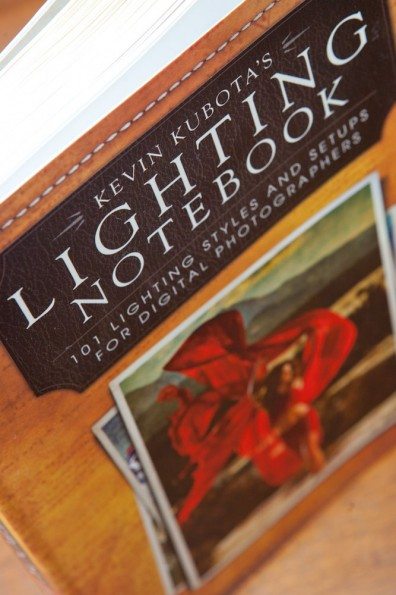Last Updated on 10/20/2011 by Travis Lawton

Being a photographer has its downsides. We work in a very fast paced, ever-changing field. We need to constantly update our style and keep on top of current trends to make sure we don’t sink into the competition sea and sink like so many before us. We do this by using several different methods, one being trying to wade through all the books and magazines to find those special ones that stick out, grab your genuine attention, and actually teach you something. I recently come across a book that does all of that: Kevin Kubota’s Lighting Notebook.
Editor’s Note: This is a guest blog posting by Travis Lawton, the Lawtographer
This book has a little of everything related to light and how it matters to photography. Kevin’s writing is very down to earth, using casual language that you would expect while having a conversation with someone rather than reading a book. The writing reminds me of a blog post actually; a really long, very detailed, and overall excellent blog post. This made it very easy to read (for me at least) and kept me wanting to turn the page to see what was next.
The book is broken into two major sections. The first, which accounts for about 25% of the book is the informative part. This includes a plethora of information about anything you’ve ever wondered about related to photography and lighting. This includes info on lighting styles, metering light, white balance, flashes and flash types, light modifiers, lighting accessories and tools, how to put together a simple lighting kit, and even a section on basic editing for your images using Adobe Lightroom.
You might be asking what the heck is in the other 75% if so much is crammed into the first quarter. Well the last 3/4’s of the Lighting Notebook is the Notebook part. This is where Kevin breaks down many different shoots, giving you detailed information about how the final image was created. Are you like me in that when you see a beautifully lit image that you know was created with the help of artificial light, you really want to know what settings were used on the camera and flash as well as where the flash(s) were place to achieve the effect? I think this has been one of the best ways to learn lighting.
I feel like this learning technique allows you to “jump into the process” by seeing every single ingredient that went into that recipe to create the final image. When you just see the final image, you think, “What an amazing photographer he must be to be able to pull that off”. However, when you know the lighting placements and all the settings you think, “Well that’s not too hard. I could do that”.
There’s a grand total of 101 lighting setups in this book and each one has the final image, brief background explanation of the image, a ballpark figure of how much the shoot will cost (as related to gear used), behind-the-scenes shots, a lighting diagram showing placement of all equipment used, and finally all setting for the flash(s) and camera. What a wealth of knowledge on each shot. The only way you could learn more would be if you were there.
I’ve purchased many photography books in my time, including this one. This was not a free review unit, but it is most certainly one of the best available. Everyone learns differently but if you’re like me in that you learn visually, you’re going to love this book. If you’re new to lighting, you will read this book cover to cover. Even if you’re a seasoned pro, you’ll still probably find a couple inspiring shooting from the 101 examples. It also helps that Mr. Kubota’s writing style is impressively easy to read.
You can see more of Travis’s work at his site and on his blog.
Please Support The Phoblographer
We love to bring you guys the latest and greatest news and gear related stuff. However, we can’t keep doing that unless we have your continued support. If you would like to purchase any of the items mentioned, please do so by clicking our links first and then purchasing the items as we then get a small portion of the sale to help run the website.


